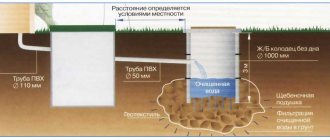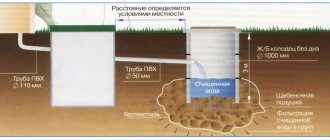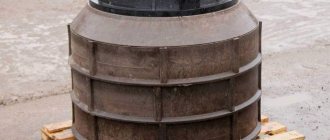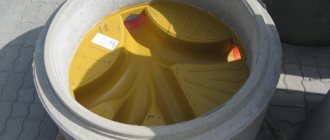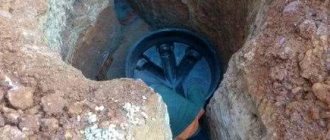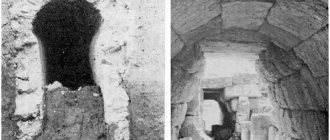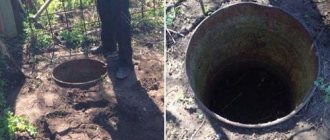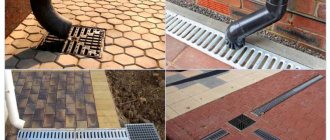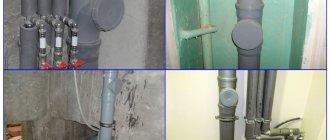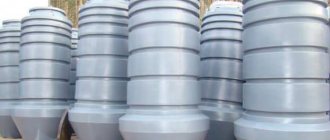Reinforced concrete rings are products made from a composite material - reinforced concrete, which includes two main components: concrete and steel.
Rings can have different sizes and diameters and are produced by casting followed by hardening of the mixture.
This is what reinforced concrete rings look like
Despite the fairly wide scope of their application in construction, reinforced concrete rings are most often used for sewerage in private houses. Z
Here, wastewater receivers - storage wells or septic tanks - are equipped with full-fledged treatment facilities.
Also, inspection sewer wells are made from concrete rings, which are located in places where pipes are laid every 30-50 meters.
Reinforced concrete rings for sewerage
What is the classification of reinforced concrete rings
If we talk about classification, it should immediately be noted that all concrete rings for sewerage are divided into two large groups: standard and Euro-rings.
In the first option, we are talking about ordinary products, which, when installing wells, are installed on top of each other, fastened at the joints using cement mortar and additional metal brackets.
Euro-rings are initially equipped with special locks or folds that provide a strong connection of several elements.
At the same time, the diameter of Euro-rings can be larger than that of conventional reinforced concrete products.
Standard and Euro rings
Sewer rings are also divided according to the grade of concrete used in their production.
In this case it will be like this: B25 and higher.
Frost resistance indicators cannot be less than F-100, and water resistance will be marked W-4.
Reinforced concrete rings for your sewerage
It should be noted that reinforced concrete rings for sewerage are classified according to the features of their design.
Here you should pay attention to the letter markings.
For example, if products are designated by a combination of letters KS, this means that you are looking at wall rings.
They are used in the arrangement of sewer systems for the construction of septic tanks and wells.
If you see markings like KSD, this means that you are being offered an additional wall ring.
ZhB ring brand KS
General characteristics
An external sewer system is impossible without wells, collectors and other reservoirs that perform various functions. Typically, to create such structures, reinforced concrete sewer rings are used, which are produced specifically for these purposes. They must meet the general requirements:
- resistance to moisture;
- absence of potholes, voids, unevenness or other surface imperfections;
- compliance with GOST requirements, full compatibility with each other and with additional elements - bottom, lid, etc.
The main quality that sewer rings must have is resistance to moisture. Ordinary concrete, which is used for standard building reinforced concrete products, is not suitable in this case. A special material is used, with plasticizing and hydrophobic additives. The color of the products should be light gray, indicating the absence of moisture.
What are the sizes of reinforced concrete rings for sewerage?
If we talk about the sizes of reinforced concrete rings, in general, then you can see these indicators in the same product markings after the letters mentioned above.
Manufacturers mostly prescribe dimensions in decimeters.
For example, if we decipher the designation KS-10-6, this means that the diameter of the product in this case is 10 dm or 1 meter.
Accordingly, the height of the ring will be equal to 0.6 m.
Ring sizes KS-10-6
It should be noted that if we talk specifically about the dimensions of concrete rings for sewerage, then everything will be much simpler.
The standard height of one product is 90 cm. The diameter can vary between 1-2 meters.
But, if you need to build a smaller structure or use non-standard rings, you should pay attention to products marked KSD.
The additional wall rings have a height of 30 and 60 cm, allowing, as a result of their combination with conventional CS, to obtain a well of the required height.
Additional wall rings
Installation process
Before proceeding with installation, it is advisable to calculate the weight of the concrete ring (what is 1 meter of well or simply sum up the weight of all elements included in the structure). As a rule, rings and other parts are mounted using special equipment - installing all this manually is quite difficult, but possible.
How to install the rings:
- Selecting a location
– drainage systems and water wells, sewer structures are not installed near residential buildings or vegetable gardens. There is a certain standard that must be followed. The farther the well is installed from all objects, the better, but no closer than 5 meters to residential buildings and structures. In addition, in the selected location you need to examine the soil for water occurrence. They also make sure that service equipment can freely approach the site.
- Digging a pit
– better using technology. A hole is dug to the depth of all the rings, several layers of sand and crushed stone (total thickness of at least 50 centimeters) are poured onto its bottom, and compacted.
- The bottom can be installed in two ways
: either using a well with a solid bottom, or installing a bottom plate and a through ring on it. Next, the rings are installed one on top of the other (preferably with the help of a crane), the joints are carefully covered with a solution, and secured with metal staples.
- Communications liner
, connections, all systems, etc., after which the pit is filled up, the rings are covered with a top slab, and a hatch is installed.
How to calculate the volume of reinforced concrete rings
In order to determine the volume of sewer well rings, you should use a special table of the ratio of sizes and volume indicators.
Here you can see such indicators as the internal diameter of the product, its wall thickness, and volume.
Accordingly, in order to determine which reinforced concrete rings are needed for sewerage, you first need to calculate the total volume of the well.
Table of reinforced concrete rings
Calculations will be carried out using a very simple formula.
Here you need to multiply three indicators:
- the number of people permanently living in the house. Let's take 5 for example;
- daily water requirement per person in liters. Today this figure is 200 liters;
- the number of days during which the wastewater is completely processed. This is 3 days.
Reinforced concrete rings for 3 cubic meters together
Thus, by making a simple calculation: 5*200*3, we get 3000 liters.
Converting this figure into cubic meters, we get 3m3.
This is exactly the volume that a sewer well should have for a family of 5 people.
Calculation of internal volume
The internal volume of the ring is calculated using a simple formula. Here you need to multiply R2 - the radius by the height of the product and by 3.14 - a constant value.
Accordingly, to obtain the radius of the ring, we need to perform the calculation in reverse order.
We divide the total volume by 3.14 and the height of the well, which in our case is 2.3 meters with a total depth of 2.5 meters.
This gives the formula: R2=3/2.3/3.14. As a result, the radius will be 0.65 m.
It turns out that the diameter of the sewer well should be 1.3 m. Such products are not produced, so we take rings with a diameter of 1.5 m.
Production technology
It has already been said about the use of steel wire with a diameter of 8-12 millimeters for the mandatory reinforcement of such structures. Two vertical rods are mounted at opposite ends from each other. These are peculiar ears that are needed when lifting the rings. The concrete caisson is installed at other stages.
The formation of voids inside is eliminated due to the effects of vibration. Thanks to this, the original shape is compacted as much as possible. After pouring the concrete, a day must pass before the formwork begins to be removed. Then the finished products are moved to open areas for storage. Tempering strength is 50% of the specified strength. You need to spend at least 7 days to collect it.
After at least 28 days, the concrete gains the desired density, including without treatment with bitumen mastic.
Advantages and disadvantages of reinforced concrete rings
Before installing a sewer system made of concrete rings, you should consider all the advantages and disadvantages of these products.
The benefits will be as follows:
Reinforced concrete rings - strength, tightness, long service life
- fairly high strength indicators;
- simple and extremely quick installation;
- high tightness, especially with additional waterproofing;
- long service life;
- affordable price.
Of course, there are also disadvantages in this case, which you also need to know when arranging a sewer system from rings made of reinforced concrete.
These include the following points:
Heavy weight, installation by machinery
- the need to rent special equipment to transport the material;
- the heavy weight of the products makes it impossible to install them manually, forcing you to seek the help of special equipment.
In any case, there are more advantages than disadvantages, and accordingly, a concrete sewer well can be called one of the most suitable options.
It remains to consider the sequence of installation work.
Additional items
To perform calculations and design, it is necessary to take into account all the elements that are included in the design. Wells are not built from rings alone; usually, various additional elements are also used for installation, making it possible to implement any system configuration.
What elements are used in the installation of well structures:
- Bottom plates
– to create a reliable foundation.
- Additional rings
– to obtain the required size of the well, if it is not possible to create it from standard products.
- Floor slabs (aka well covers)
– for covering the top of the well and the space under the hatch.
There are also rings with covers, which represent the combination of a ring and a cover into a monolithic structure in a factory environment.
Covers for wells
The lid is a round plate that covers the ring, with a hole in the center or side. In drainage wells, covers are installed with a hole for a hatch in the center, for other purposes - on the side.
Covers are made from heavy, high-strength concrete of minimum class B15, waterproof and frost-resistant. For installation and loading/unloading, the product is equipped with reinforcement loops.
Bottom plates
These are prefabricated reinforced concrete elements for the installation of underground engineering structures and communications. The plates become the base for the chamber, and rings are mounted on top of them. Thanks to the bottom slabs, it is possible to ensure the tightness of the well and protect it from destruction, moisture ingress and soil collapses. Before choosing a bottom slab, you need to know how much the concrete ring weighs in order to correctly calculate the load.
Bottom plates are a round product along the diameter of the well. It is made of concrete with frost resistance of at least F100, water resistance of at least W6, strength B15 and higher.
Support rings
These are special elements on which the well hatch rests. Products are round in shape along the outer diameter of the well, of small thickness with an internal hole diameter of at least 70 centimeters, so that if necessary, a person can get inside. The weight of the concrete ring is about 50 kilograms. Concrete meets all requirements and standards.
Rings with caps
Such products involve combining two elements - a ring and a lid - in a factory environment. A finished product is delivered to the site, replacing the other two.
In this way, it is possible to avoid unnecessary connections and achieve greater tightness, reduce the volume of installation work and speed up the assembly of the well.
External waterproofing
The main purpose is to prevent negative environmental impacts. The most convenient implementation is when similar processing is used while laying the rings. Otherwise, you will then have to manually dig out the finished trunk. Inspection and sewer wells are completely exposed. For drinking water you need 50 centimeters from the water level mark. Work is carried out at an air temperature of +5 degrees. A caisson for a well requires the same conditions.
Materials are applied only to dry substrates, then everything will stick well. If the well is operational, it must first be drained. In any case, the outer walls are cleaned of dirt and dust, and any defects on the surface.
A separate stage is impregnation using a primer. It depends on the type of well which brand should be used in a particular case. And what kind of caisson is being installed for the well.
Leveling the outer surface of the rings and laying waterproofing are the last stages. External seams are also covered with additional materials. The rings are covered with earth on top when the products are completely dry.
Reinforcement
Reinforcement of rings is necessary to increase their service life. Reinforced elements are made using the same vibration pressing method, during which they acquire a more dense structure and become stronger.
In addition, such products have increased water resistance, which allows them to be used for constructing septic tanks that prevent water from entering the ground. The same can be said about groundwater: the tight fit of the component parts to each other eliminates the possibility of the formation of large gaps, and groundwater will not flow into the well source.
